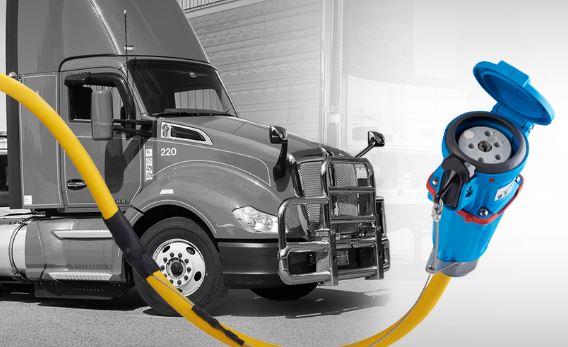SafeConnect®’s Electric Standby Connection System for Hybrid eTRUs Named to the Approved Package List by Southern Cal Edison

Product to Help Cut Emissions as New Climate Change State Law Gains Momentum
With the California Air Resource Board’s (CARB) groundbreaking proposal to move the state’s expansive road transportation system to nearly net-zero emissions, Southern California Edison (SCE), has approved SafeConnect’s innovative electric standby connection system for eTRUs to the off-road Approved Package List (APL). This approval automatically qualifies SafeConnect for approval on Pacific Gas & Electric’s (PG&E) EV Fleet program and San Diego Gas & Electric’s (SDGE) incentive programs. This news complements existing grant programs available to businesses to develop electric infrastructure at their locations for use by medium- and heavy-duty fleet vehicles.
SafeConnect’s Electric Standby Connection system is an Environmental Protection Agency (EPA) SmartWay® Verified technology and is designed to allow refrigerated trucks and trailers to plug into the electric grid when parked, reducing diesel emissions. The SafeConnect system features a patented and unique design, with a six-pin safety control circuit and a true tension release plug that protects people and equipment from the mishaps and the dangers of high-voltage electricity.
“Being added to the Approved Package List by a major California utility is a step forward for our company,” said Bobby Johns, Director of Business Development, SafeConnect Systems. “Utility companies are leading the charge for change by offering substantial grants, and SafeConnect is here to help support their programs with an industry-leading, safe and reliable product. It is exciting to be a part of California’s pioneering effort to reach its net-zero carbon emissions goal and help businesses transition to electric standby. We’re honored that these utilities recognize our product as a viable solution.”
Grant Programs Enabling Change in Charging Infrastructure for Transport-Reliant Businesses
SCE has launched Charge Ready Transport, a program modeled after its Charge Ready Program for electric passenger cars that aims to add charging stations for medium- and heavy-duty electric vehicles at a minimum of 870 commercial sites within the utility’s 50,000 square-mile service area. The $356-million SCE grant program will support the installation of infrastructure for at least 8,490 industrial vehicles over a five-year period.
With the goal of 700+ organizations converting to electric vehicles for large fleet transport by 2024, PG&E has introduced a similar program called EV Fleet. This program provides funding to cover installation of charging infrastructure for fleet businesses. The program offers a $3,000 per vehicle incentive cap for companies that use transportation refrigeration units (TRUs), as well as further incentives and rebates to cover site design, permitting, construction evaluation, and ongoing maintenance.
Lastly, SDGE offers a financial incentive program for companies looking to retrofit existing equipment or install new, high-efficiency equipment to help save energy and meet California’s net-zero emissions goals. The incentive amount differs from the other two utility company programs by focusing on the end goal – how much energy the company’s project ends up saving – meaning the more energy a business saves, the more incentive they reap. The baseline incentive savings rates are $.12/kWh for electric, $1.25/therm for gas, and $150/kW for peak reduction.
California’s Environmental Protection Efforts
With the EPA considering diesel carbon emissions to be one of today’s greatest air quality challenges, CARB continues to move the needle on standards for environmental protection by pushing forward the net-zero carbon emissions by transport bill. Within the proposed anti-idling legislation are new regulatory requirements from CARB that place TRUs squarely in their sights.
This proposal would prohibit TRUs from idling for more than 15 minutes at applicable facilities without plugging in and switching to electric standby by 2023; applicable facilities include any refrigerated warehouse greater than 20,000 sq. feet, or any grocery store greater than 15,000 sq. feet.
How TRUs Play a Role in Cutting Carbon Emissions
TRUs are used to haul and store food, pharmaceuticals, chemicals, and other products that require refrigeration. It’s not unusual for TRUs to be parked or staged at loading facilities, warehouses, grocery stores, and even event venues, or near residential neighborhoods for days or weeks at a time. With traditional TRUs, diesel powers the motor that keeps the refrigerated trailer at the correct temperature at all times. CARB’s proposal will reduce the time that a diesel- engine can power a TRU.
California is a huge distributor of produce and other refrigerated food and the proposed CARB regulations will not only directly affect truck drivers in the state, but also anyone who conducts trucking business there. To meet the pending regulations, companies reliant on refrigerated trucking (e.g., grocery, pharmaceuticals, veterinary, and more) will need to find new solutions for safe, environmentally sound, plug-in options. SafeConnect’s electric standby connection system fills the void for both of those issues. Rather than waiting for the new environmental laws to go into place, SafeConnect is working to share their product knowledge and help companies get ahead of the regulations by outfitting their trailers and facilities with electric standby capabilities.
Category: Connected Fleet News, Driver Stuff, Electric Vehicles, Equipment, Featured, Fuel & Oil, General Update, Green, News










